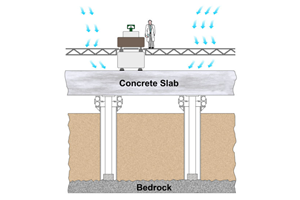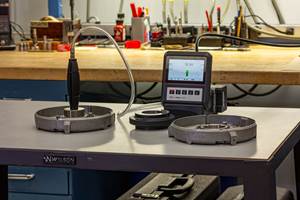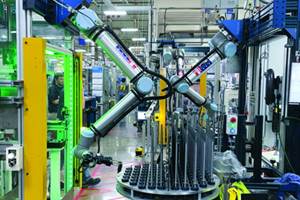Get The Most Out Of Your Measuring System
With the implementation of touchscreen operation, canned measurement routines and automatic ranging, form measuring machines have become nearly foolproof and have successfully migrated from the lab to the shop floor. Still, the form machine is only as good as its setup, and without due attention to the basics, there are many pitfalls that can make even the most basic measurement useless.
Share


.png;maxWidth=45)
DMG MORI - Cincinnati
Featured Content
View More


Hwacheon Machinery America, Inc.
Featured Content
View More

ECi Software Solutions, Inc.
Featured Content
View MoreWith the implementation of touchscreen operation, canned measurement routines and automatic ranging, form measuring machines have become nearly foolproof and have successfully migrated from the lab to the shop floor. Still, the form machine is only as good as its setup, and without due attention to the basics, there are many pitfalls that can make even the most basic measurement useless. In this column, we’ll highlight some of the most common problems.
Erroneous Staging—As with any dimensional check, unless a part is staged correctly, unwanted errors are apt to appear in the measurement results. A three-jaw chuck is often used to stage a workpiece, but using one on a thin-walled part may introduce a three-lobed condition in the measurement. Likewise, special clamping may be needed to stabilize a tall, narrow part.
Using the wrong stylus tip—Often, the operator of a form measuring system will use only the probe initially supplied with the machine, regardless of the size of the part being measured. However the stylus tip really acts as a mechanical filter and needs to be selected according to part diameter and the maximum number of undulations per revolution relative to the application. The manufacturer of the form machine probably has a whole host of measuring probes available for the transducer. In addition to the need for different ball sizes and contact shapes, other materials may be required. Sometimes conflicts between the part and the tip causes probe chattering or even "picking up" material on the probe, thus changing its characteristics over time.
Choosing the wrong type of signal processing filter—Originally, the filters in form measuring systems were analog and used resistors and capacitors. These were referred to as 2RC filters. When computers started taking over the form tasks, digital filters were created to simulate these 2RC filters. The newest systems use digital Gaussian filters, which are more accurate than the 2RC filters and tend to introduce less distortion. Because of these characteristics, they are becoming the filter of choice in the newer standards. Please be aware that older systems will not correlate with new form systems, which may make them obsolete to the standards.
Confusion over the way the results look—The results of a form measurement rarely look "round" on the computer screen or printout. It is quite common for the trace to have sharp high and low points that can fool the user into thinking the part has terrible form errors.
Computer-based form systems normalize the deviation around a fixed circle. The operator then chooses the best magnification to balance the form error to the specific surface deviations. While the computer trace does not accurately represent the part’s actual profile, the relationship between the highs and lows remains consistent with the system’s magnification and represents accurate angular relationships around the circumference of the trace.
Measuring the wrong parameter—Geometry parameters are typically a source of confusion. For example, in the case of a simple indicator gage, the term "runout" and "out-of-roundness" are used interchangeably. However, they are not the same when measuring form and should be measured differently. Similarly, when gaging perpendicularity, parallelism and other parameters involving relationships between two surfaces, the user must understand which surface needs to be measured first.
For example, the statement often seen on a print, "B is parallel to A," is not the same as "A is parallel to B." By definition, the second surface in the statement is considered the reference or datum surface. All of these parameters and more are defined in the ANSI Y14.5M Standard.
Inattention to centering and leveling—As part of staging, proper centering and leveling are critical elements for correct form measurement. A round part that is not level will produce an oval trace, while an off-center part will produce a trace that almost resembles a heart. If the form gage has a fixture to quickly align the part, it is wise to make sure that the part is in the fixture properly and is centered and aligned. Even if the form machine has centering and tilt correction as part of its software package, the closer you get to true center and level, the better your results will be.
The above-mentioned examples are only a few of the most common form measurement problems.
Related Content
How to Calibrate Gages and Certify Calibration Programs
Tips for establishing and maintaining a regular gage calibration program.
Read MoreHow to Mitigate Risk in Your Manufacturing Process or Design
Use a Failure Mode and Effect Analysis (FMEA) form as a proactive way to evaluate a manufacturing process or design.
Read MoreHow to Choose the Correct Measuring Tool for Any Application
There are many options to choose from when deciding on a dimensional measurement tool. Consider these application-based factors when selecting a measurement solution.
Read More4 Steps to a Cobot Culture: How Thyssenkrupp Bilstein Has Answered Staffing Shortages With Economical Automation
Safe, economical automation using collaborative robots can transform a manufacturing facility and overcome staffing shortfalls, but it takes additional investment and a systemized approach to automation in order to realize this change.
Read MoreRead Next
Building Out a Foundation for Student Machinists
Autodesk and Haas have teamed up to produce an introductory course for students that covers the basics of CAD, CAM and CNC while providing them with a portfolio part.
Read MoreRegistration Now Open for the Precision Machining Technology Show (PMTS) 2025
The precision machining industry’s premier event returns to Cleveland, OH, April 1-3.
Read MoreSetting Up the Building Blocks for a Digital Factory
Woodward Inc. spent over a year developing an API to connect machines to its digital factory. Caron Engineering’s MiConnect has cut most of this process while also granting the shop greater access to machine information.
Read More































.png;maxWidth=300;quality=90)














